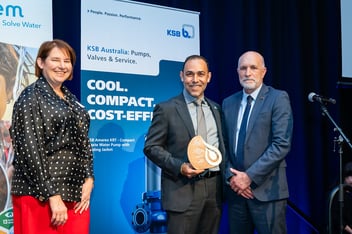Lessons Learnt from our Regional Communities

The remote Mer Island community in the Torres Strait has endured over twenty years of strict water restrictions. In 2021 the Torres Strait Island Regional Council (TSIRC) in collaboration with demand management specialist Asset Life Alliance (ALA) implemented an integrated plan to firstly stabilize the island’s water network through an onsite leak detection program and lift water restrictions for the first time, and then by installing a range of innovative industry technologies ensure the water network could be sustainably management into the future.
As a result of the outcomes of this work TSIRC was awarded the Infrastructure Project Innovation Award (Regional) at the 2021 QLD AWA awards.
The Issue
Mer (Murray) Island is a small volcanic island populated by the Meriam people (Torres Strait Islanders). It is the most easterly inhabited island of the Torres Strait and one of the most remote communities in Australia, it has a population of approximately four hundred and fifty people. At the commencement of this project residents of Mer only had access to six hours of water supply per day. These restrictions were the result of major water losses in the network leading to ongoing water supply shortages. TSIRC’s Water & Wastewater Department had made numerous attempts to address these losses using traditional resource intensive manual techniques, such as network isolation testing and repeated meter reads with minimal gains achieved.
The Mer communities has a 17.5ML covered lagoon for water storage, the lagoon had never reached capacity and was regularly at critically low levels. The lagoon is supplemented with rainwater captured on the covers and desalinated water, with desalinated water making up approximate ninety percent of the supply. During times for critical water supply mobile desalination plants are barged in from other islands to assist with demand.
TSIRC is a small Council which represents fifteen unique island communities spread across 42,000km2 of sea, located between Cape York and Papua New Guinea. The Council has a small engineering team, which manages fifteen water schemes and twelve wastewater schemes. With so many schemes to manage spread across such a large area the Engineering Team’s resources are generally stretched. Through this project the team sought a more effective and sustainable way to manage the Mer Island water scheme.
Approach
In 2021 TSRIC in collaboration with ALA developed an integrated two stage plan to address water losses in the Mer Island network. The first stage was to implement an onsite leak detection and repair intervention program to stabilize the network and bring the community off water restrictions. Following this a range of innovative new industry technologies for network monitoring and regulation would be adopted to ensure the long-term sustainable management of the network.
The preliminary intervention program was completed over several site visits to Mer Island. ALA worked with TSIRC staff on the ground to identify all network and residential leaks. This program also provided key operational TSIRC staff with onsite leak detection training. All leak repairs were completed by TSIRC staff.
The implementation of monitoring and automated technologies included the installation of smartmeters to all properties, a bulk magflow meter at the community’s main reservoir, inline acoustic leak sensors with AI monitoring, and automated network pressure controls to regulate pressure zones within the network. These technologies allowed for the remote monitoring of the water network. TSIRC’s main logistics office is in Cairns, some 780km south of Mer Island. Remote monitoring capabilities are critical for TSIRC to manage its water and wastewater schemes.
Outcomes and measurable impacts
The site investigation found the cause of water losses was due to a cumulative effect of many small leaks throughout the mains network and within properties. The installation of smartmeters with trending data has greatly improve Council’s capacity to monitor and address losses within property boundaries. While the new acoustic sensors coupled with the skills learnt through the onsite leak detection investigations have greatly improved TSIRC’s capacity to locate and repair subterranean leaks. The network pressure controls have reduced pressure in the network by over sixty percent, leading to significantly lesser stresses on network pipes and fittings, and slowing leak rates while still providing suitable water pressures to all properties.
At the completion of the leak intervention program, Mer Island’s water network was stabilized, and water restrictions were lifted for the first time since the network was constructed. Daily water demand had reduced by approximately fifty percent (even with restrictions removed) and within two months of the network being stabilized the islands covered lagoon reached capacity for the first time ever. The island’s desalination units which had always needed to be run to address water shortages could be run at planned intervals, and overall desalination production demand was reduced by over forty percent.
The operation of mobile and permanent desalination plants comes at a consideralble cost to TSIRC. The desalination units are powered by diesel generators, the forty percent plus reduction in production demand has resulted in similar reductions in operational costs and diesel usage. It is estimated that the savings made in operational costs will offset the total cost of this project within the first two years. The stabilization of the Mer network has also reduced TSIRC’s operational stresses at this site. Consequently, the Council can redirect funds and resources to other critical issues across the region.
Water security is a major issue across many of TSRIC’s island communities, the strategies learnt through this project have provided the Council with more efficient ways to manage all its water networks. TSIRC is a small council which relies heavily on external funding to implement capital works projects. The various components of this project would not have been possible without the well-informed funding support provided from both State and Federal Governments.

